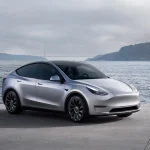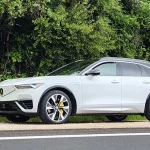
Silicon anodes to boost lithium-ion battery capacity within a few yearsSilicon anodes to boost lithium-ion battery capacity within a few years
The main impediment to mass electric-car adoption is price, and the driving force behind that is the cost of lithium-ion battery cells.
The performance of those cells improves at about 7 percent a year, give or take: Either the same cell costs 7 percent less after a year, or a carmaker gets 7 percent more energy capacity for the same price.
Those improvements come from a combination of economies of scale, tweaks to the battery chemistry, fabrication improvements, and higher yields.
DON’T MISS: Electric-car batteries: $100 per kwh before 2020, $80 soon after? (Feb 2017)
Now, however, battery engineers suggest that more of a step change may arrive by 2020 to 2022—potentially double-digit increases in the energy storage capacity of individual cells.
The new developments were summarized Sunday by The Wall Street Journal (subscription may be required). What was pure laboratory research five years ago is now moving closer to production.
The “secret sauce” is the use of anodes made from silicon, rather than the graphite (essentially crystalline carbon) used almost across the board in today’s cells.
2017 BMW i3
Of the two electrodes in every cell, the anode is the one that discharges lithium ions that travel through the electrolyte and are absorbed into the cathode. Charging the cell reverses the process.
Theoretically, silicon could absorb and hold many times the number of lithium ions that carbon can, but limiting that process to prevent destruction of the anode is just one of the many technical challenges to making such cells practical.
Today’s graphite anodes blend small amounts of silicon into the carbon to boost range, but most likely 10 percent or less.
READ THIS: Researchers Create Pure Lithium Anode, ‘Holy Grail’ For Battery Cell (Jul 2014)
The Wall Street Journal piece focuses on several startup companies that claim to be close to production-ready cells with anodes largely made from silicon. Among them are Angstron Materials , Enovix, Enevate, and Sila Nanotechnologies.
Using nanoparticles to ensure the cells have plenty of space for lithium ions to be absorbed without swelling or shattering the anode, those makers claim capacity increases of 20 to 40 percent over the best comparable graphite-anode cells.
Now being tested around the world by dozens of potential customers, these so-called lithium-silicon cells will appear first in small versions used in high-end consumer electronics devices.
2018 BMW i3, 2017 Frankfurt Motor Show
The timeline there is expected to be roughly two years, likely meaning early 2020.
But using them in electric cars will require far more durability and stress testing, to ensure they will last not just the two or three years required for a mobile phone but over a vehicle life of 10 to 15 years.
BMW has said it will use cells from Sila Nanotechnologies in a plug-in electric vehicle by 2023. The German luxury maker plans to spend €200 million ($246 million) to establish and staff its own battery-research center for future plug-in vehicles planned throughout the 2020s.
CHECK OUT: BMW partners with Solid Power to develop solid-state cells for electric cars
The greater safety and durability margins required for automotive battery packs may somewhat lessen the impact of the new anode technology.
BMW, for example, expects a battery capacity boost of 10 to 15 percent above the increases projected from today’s lithium-graphite cells, a company spokesperson told the Wall Street Journal.
As well as reducing the cost of batteries, the greater energy density will allow either longer-range batteries in the same form factor or smaller batteries, giving vehicle designers even greater flexibility to shape and position battery packs for the electric cars of 2025 and beyond.
View original article at: “https://www.greencarreports.com//news/1115806_silicon-anodes-to-boost-lithium-ion-battery-capacity-within-a-few-years”
Add a comment Cancel reply
Comments (0)
รถพยาบาล
… [Trackback]
[…] Find More here on that Topic: autoseu.com/silicon-anodes-to-boost-lithium-ion-battery-capacity-within-a-few-yearssilicon-anodes-to-boost-lithium-ion-battery-capacity-within-a-few-years/ […]
this content
… [Trackback]
[…] Here you can find 19194 more Information to that Topic: autoseu.com/silicon-anodes-to-boost-lithium-ion-battery-capacity-within-a-few-yearssilicon-anodes-to-boost-lithium-ion-battery-capacity-within-a-few-years/ […]
สล็อตวอเลท
… [Trackback]
[…] Find More on that Topic: autoseu.com/silicon-anodes-to-boost-lithium-ion-battery-capacity-within-a-few-yearssilicon-anodes-to-boost-lithium-ion-battery-capacity-within-a-few-years/ […]
토렌트 사이트
… [Trackback]
[…] Here you will find 10689 additional Info to that Topic: autoseu.com/silicon-anodes-to-boost-lithium-ion-battery-capacity-within-a-few-yearssilicon-anodes-to-boost-lithium-ion-battery-capacity-within-a-few-years/ […]
Categories
- Activism (1)
- Adventure (1)
- Advertising (2)
- Agriculture (1)
- Air pollution (4)
- Air transport (3)
- aluminium (2)
- Amazon (3)
- Animals (1)
- Apple (2)
- Architecture (1)
- Arctic (1)
- Artificial intelligence (1)
- Augmented Reality (1)
- Auto Detailing (1)
- autopilot (1)
- battery (31)
- Best summer holiday destinations 2022 (1)
- Bicycle (1)
- biodiversity (1)
- BMW (2)
- boat (1)
- Bus (1)
- Business (4)
- Buying Guides (1)
- car (7)
- Car industry (18)
- Car News (18)
- car rental (3)
- Car Reviews (4)
- Car sales (6)
- carbon emissions (15)
- carbon footprint (3)
- Carlos Ghosn (1)
- Cars (66)
- Central Europe (1)
- CES (2)
- charging station (11)
- Children (1)
- China (12)
- Citroën (1)
- city (1)
- City transport network (2)
- clean energy (2)
- Climate (1)
- climate change (9)
- Climate crisis (4)
- Climate emergency (2)
- climate protection (2)
- CO2 emissions (39)
- Company (3)
- Competition (1)
- Conscious travel (2)
- Contamination of water (1)
- Copper (2)
- cost of living (2)
- Cuba (1)
- Cuban politics (1)
- Cybertruck (1)
- Cycling (1)
- deforestation (1)
- delivery (3)
- Denmark (2)
- Detroit (1)
- Diesel (4)
- Diesel car (7)
- e-mobility (11)
- e-scooter (2)
- Eco travel (3)
- Eco-friendly (2)
- Ecology (1)
- Economy (1)
- El Niño (1)
- Electric (11,302)
- Electric boats (1)
- electric car (107)
- Electric Cars (499)
- Electricity (5)
- Electricity consumption (3)
- Electricity market (5)
- Elon Musk (21)
- emission (1)
- Emmanuel Macron (1)
- Energy (2)
- Energy low cost (1)
- energy transition (6)
- Entrepreneur (1)
- Environment (5)
- Environment pollution (1)
- Environmental protection (4)
- EU Policy (1)
- EU-China (2)
- Europe (7)
- Europe's energy crisis (1)
- European Commission (3)
- European economy (2)
- European Union (18)
- Euroviews (6)
- Eviction (1)
- EVs (37)
- F1 (1)
- factory (4)
- fake news (1)
- family (2)
- Ferrari (1)
- fertilizer (1)
- fine (penalty) (1)
- fire station service (1)
- flight (1)
- Flying car (4)
- Food security (1)
- Ford (1)
- Formula 1 (2)
- Fossil fuels (14)
- France (39)
- free trade (1)
- Fuel (3)
- Fuel cell electric vehicles FCEV (10)
- fuel crisis (2)
- Fuel Efficiency (3)
- fuel prices (1)
- Funeral (1)
- Gas (1)
- Gas Prices (1)
- gasoline price hike (1)
- German (1)
- Germany (8)
- Giorgia Meloni (1)
- Global warming and climate change (1)
- Good News (1)
- Greece (1)
- green energy (1)
- green new deal (1)
- Green transportation (17)
- Green Week (1)
- greenhouse gas emissions (6)
- Hanoi (19)
- Health (1)
- home (2)
- homelessness (1)
- Housing market (19)
- human rights abuse (1)
- Hybrid (2,283)
- Hybrids (116)
- Hydrogen (2)
- hydrogen vehicle (2)
- IAA Mobility (2)
- Iceland (3)
- incident (1)
- income (1)
- India (2)
- Indonesia (1)
- infrastructure (1)
- innovation (1)
- International relations (1)
- Investment (4)
- iPhone (1)
- Japan (1)
- Jobs (3)
- Joe Biden (4)
- Jubilee (1)
- Lampedusa (1)
- Las Vegas (1)
- lead petrol (2)
- Lithium (13)
- liveable cities (2)
- London (3)
- Luxembourg (1)
- Luxury (2)
- luxury goods (2)
- Luxury lifestyle (2)
- Manufacturing (5)
- Market (1)
- Markets (1)
- meat (1)
- Mercedes-Benz (39)
- Migrants (1)
- minerals (2)
- Mining (5)
- Mitsubishi Motors (1)
- Mobile World Congress (1)
- Mobility (10)
- Mobility Week (2)
- Mobility Week 2021 (1)
- Mobility Week 2023 (5)
- money (3)
- Motorcycling (2)
- Motorsport (1)
- Mountain (1)
- NASA (1)
- nature (2)
- net-zero (2)
- New technologies (6)
- Next Explainers (1)
- Next In data (2)
- Nigeria (1)
- Nissan (3)
- Norway (7)
- Nuclear Energy (1)
- nuclear fusion (1)
- Nuclear power plant (1)
- Odd (1)
- oil industry (1)
- Olaf Scholz (1)
- online shopping (1)
- Oslo (1)
- Paris (1)
- parody (1)
- Petroleum products (3)
- Peugeot (1)
- plastic (1)
- Poland (1)
- Politics (1)
- Pollution (44)
- Power Plant (1)
- prices (1)
- production (1)
- Profits (1)
- Prostitution (1)
- Public transport (4)
- Racing cars (1)
- Racism (1)
- Rail transport (2)
- rats (1)
- Raw material (1)
- Recycling (4)
- Renault (3)
- Renewable energies (6)
- renewable energy (6)
- Reykjavík (1)
- Rishi Sunak (1)
- road (36)
- Road infrastructures (1)
- Road safety (7)
- Road transport (20)
- road trip (1)
- Robot (1)
- Rolls Royce (1)
- Russia (1)
- Russia's invasion of Ukraine (2)
- Sadiq Khan (1)
- safari (1)
- Safety (1)
- Sale (1)
- sales (3)
- Scotland (1)
- self-driving (43)
- Semiconductor (1)
- Shares (1)
- Show (1)
- Silicone (1)
- Software (1)
- Solar energy (2)
- solar power (5)
- Space technology (1)
- Spain (1)
- start-up (3)
- Stock exchange transaction (1)
- Stock market activity (1)
- Stockholm (1)
- Strasbourg (1)
- Students (1)
- Summer Olympics (2)
- Sustainability (7)
- Sustainable city (3)
- Sustainable design (3)
- Sustainable development (1)
- Sustainable innovation (9)
- Sustainable technology (21)
- Sustainable tourism (4)
- Sweden (2)
- Tata Motors (2)
- Tax (37)
- Taxes (2)
- Taxi (1)
- Technology (55)
- Tesla (73)
- The Boring company (1)
- Tokyo Olympic Games 2020 (1)
- Toyota (4)
- trade (3)
- traffic (1)
- Trains (2)
- Transport (11)
- transportation (3)
- Travel destinations (1)
- Tunnel (1)
- Twitter (3)
- UBER (1)
- Ukraine war (1)
- Uncategorized (6)
- United Kingdom (5)
- United States (6)
- urban planning (2)
- Ursula von der Leyen (3)
- US politics (1)
- USA (1)
- vegan (1)
- vehicle (7)
- Video (4)
- Vietnam (19)
- Volkswagen (3)
- Volvo (2)
- waste (1)
- waste disposal (1)
- Water (1)
- Water resources (1)
- White House (1)
- wind energy (1)
- Wind turbine (1)
- Winter (2)
- work conditions (1)
- World Travel Market (1)
- Xiaomi (1)
Recent Posts
About us

Popular Tags
Related posts


Volvo EX30 in the test: Really a premium car at a volume price?

VW ID.7: Estate is not called Variant... It's a Tourer







